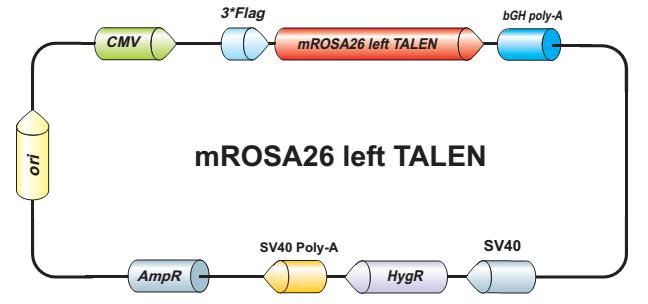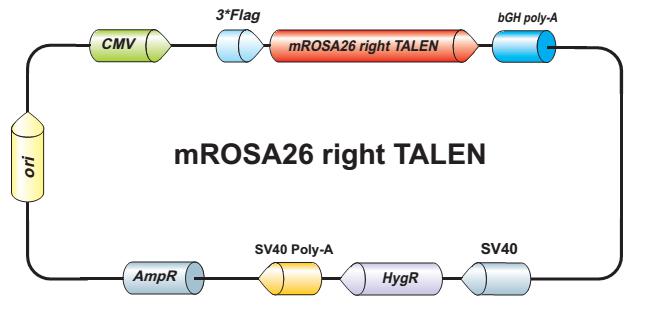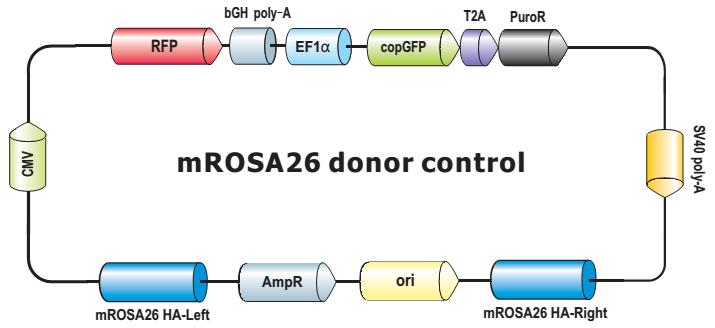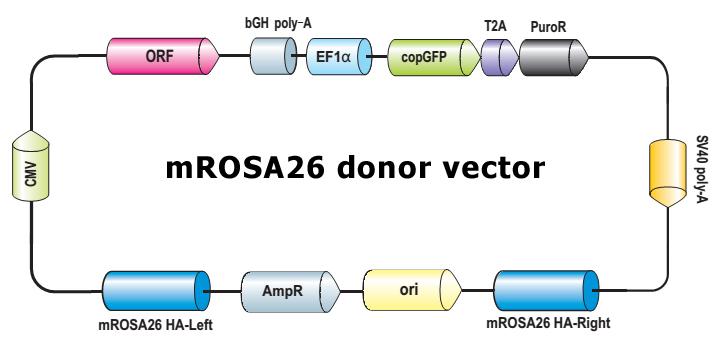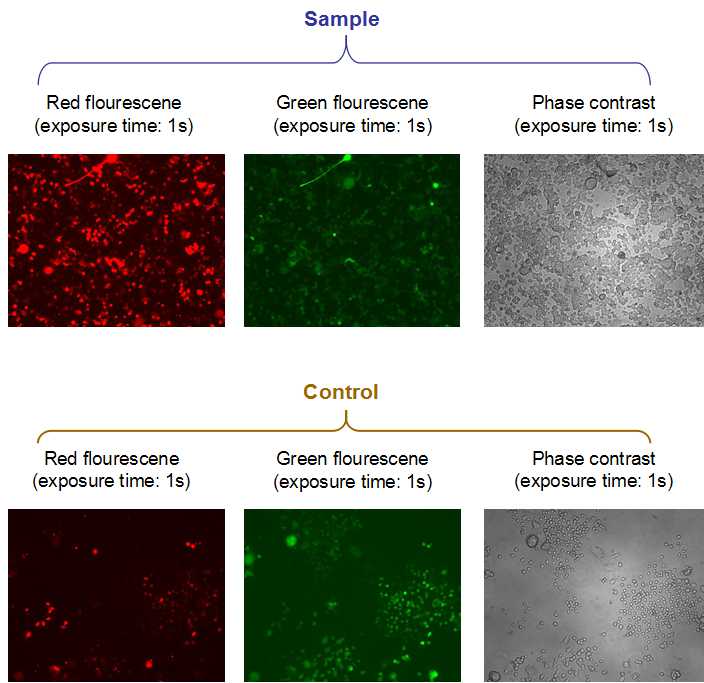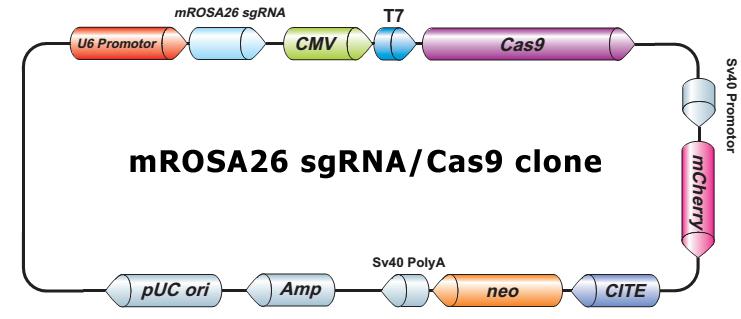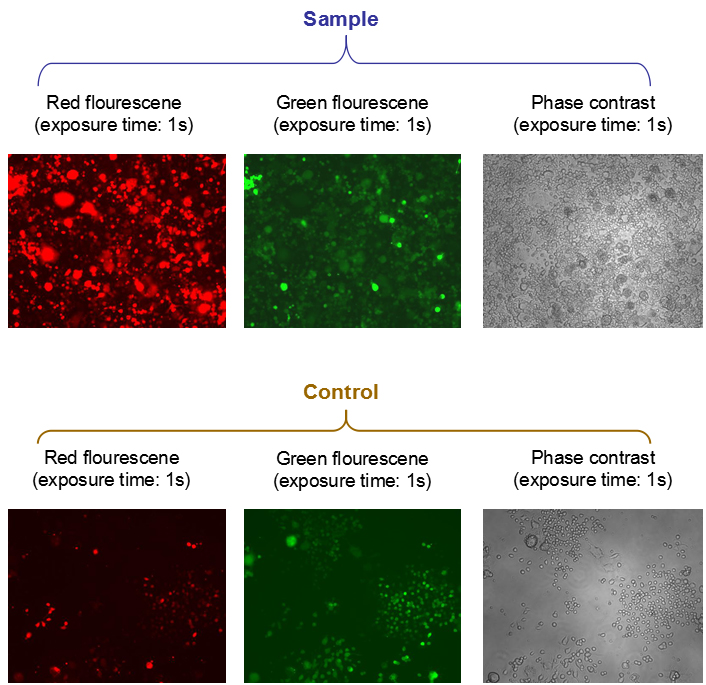Mouse ROSA26 safe harbor gene knock-in kits and clones
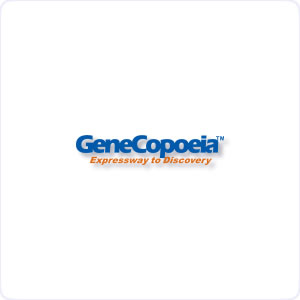
Genome-TALER™mouse ROSA26 safe harbor gene knock-in kit

Genome-TALER™ mouse ROSA26 safe harbor gene knock-in kit (without donor)

GeneHero™mouse ROSA26 safe harbor gene knock-in kit

GeneHero™ mouse ROSA26 safe harbor gene knock-in kit (without donor)
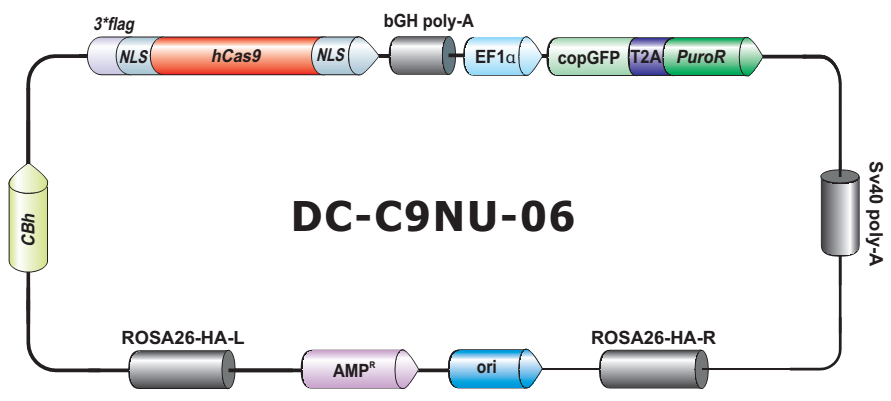
Cas9 ROSA26 knockin donor clone-Puro
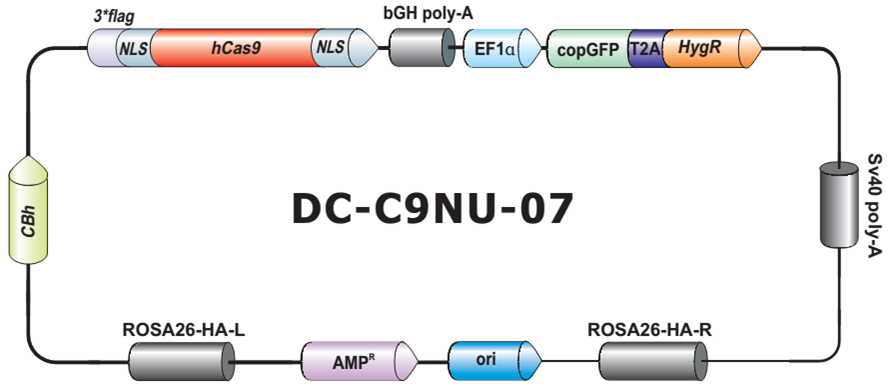
Cas9 ROSA26 knockin donor clone-Hygro
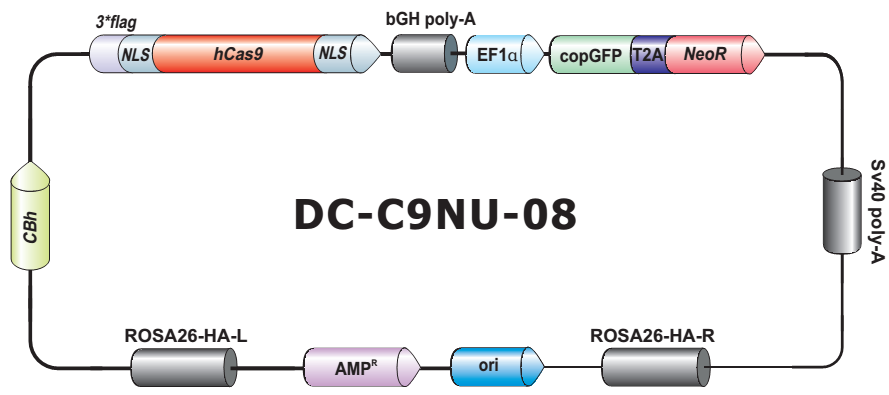
Cas9 ROSA26 knockin donor clone-Neo

Introduction
ROSA26 (also known as ROSAβgeo26 locus) in the mouse genome is first found in chromosome 6 in one particular strain of mice-named ROSAβgeo26-expressed β galactosidase from a randomly inserted transgene at high levels uniformly in nearly all tissues examined. This locus expresses one coding transcript and two noncoding transcripts, and only the non-coding transcripts are disrupted by the insertion. While pups homozygous for the insertion are born at slightly lower frequency than heterozygous pups, homozygotes appeared to develop normally and were fertile. Thererore, the “Rosa26” locus has since been used as a transgene insertion site that causes no apparent adverse effects on fitness, and permits stable gene expression.
ROSA26-specific TALENs or CRISPR-Cas9 can generate a DNA double-strand break (DSB) at ROSA26 in the mouse genome, stimulating natural DNA repair mechanisms. In the presence of ROSA26 ORF knockin clones, homologous recombination (HR) occurs and integrates DNA fragments from knockin clones into the safe harbor locus.

TALEN Kits
The kits are designed to specifically transfer your gene of interest, selection marker or other genetic element into the ROSA26 safe harbor site in mouse genome via TALEN-mediated homologous recombination.
The Genome-TALER™ mouse ROSA26 safe harbor gene knock-in kit includes one pair of ROSA26 TALENs, one donor cloning vector or one donor clone*, one positive control clone and one knock-in PCR verification kit.
Figure 2. Genome-TALER™ mouse ROSA26 safe harbor gene knock-in kit. (A) ROSA26 TALEN and donor DNA plasmids (B)ROSA26 knock-in verification PCR primers
| Cat. No. |
Components |
Description |
Qty |
TN-ROSA26-L |
ROSA26 left TALEN |
Specifically cleave ROSA26 with target site TN-ROSA26-R to create DSB |
1 |
TN-ROSA26-R |
ROSA26 right TALEN |
Specifically cleave ROSA26 with target site TN-ROSA26-L to create DSB |
1 |
DC-DON-SH02* |
ROSA26 donor cloning vector |
For cloning GOI or containing GOI
-Two ROSA26 flanking arms for HR
-CMV promoter
-GFP/Puro marker for selection |
1 |
DC-RFP-SH02 |
ROSA26 positive control donor clone |
RFP instead of GOI for positive control purpose |
1 |
MQPROSHR-5 |
5′ knock-in verification PCR primer pair |
PCR primer pairs for 5’ HR junctions to verify successful integration |
1 |
MQPROSHR-3 |
3′ knock-in verification PCR primer pair |
PCR primer pairs for 3’ HR junctions to verify successful integration |
1 |
* DC-DON-SH02 only comes with SH-ROS-K100 kit. ROSA26 ORF knock-in clones and other ROSA26 donor clones can be custom-made by us.
| (C) |
|
 |
Figure 3. Mouse genome safe harbor ROSA26 gene targeting
(A) ROSA26 RFP control plasmid DC-RFP-SH02 (800 ng) was co-transfected with ROSA26 TALEN pair (600 ng for each) or control only DC-RFP-SH02 (800 ng) transfected into mouse Neuro2a cells in a 6-well plate.
(B) 48 hr post-transfection, the cells were split 1:10 into a new 6-well plate and selected against 1.0 µg/ml of puromycin. The images were taken after two weeks of selection. Few colonies left in the wells transfected with only ROSA26 RFP control.
(C) PCR primers designed to amplify the HR junctions were used to verify the specific and successful integration. |
CRISPR kits
The kits are designed to specifically transfer your gene of interest, selection marker or other genetic element into the ROSA26 safe harbor site in mouse genome via CRISPR-Cas9-mediated homologous recombination.
The GeneHero™ mouse ROSA26 safe harbor gene knock-in kit includes a ROSA26 sgRNA/Cas9 expression clone, one donor cloning vector or one donor clone*, one positive control clone and one knock-in PCR verification kit.
Figure 4. The GeneHero™ mouse ROSA26 Safe harbor gene knock-in kit. (A) ROSA26 sgRNA/Cas9 expression clone and donor DNA plasmids (B) Knock-in verification PCR primers
| Cat. No. |
Components |
Description |
Qty |
MCP-ROSA26-CG01 |
ROSA26 sgRNA/Cas9 expression clone |
Specifically cleave ROSA26 target site to create DSB |
1 |
DC-DON-SH02* |
ROSA26 donor cloning vector |
For cloning GOI or containing GOI
-Two ROSA26 flanking arms for HR
-CMV promoter
-GFP/Puro marker for selection |
1 |
DC-RFP-SH02 |
ROSA26 positive control donor clone |
RFP instead of GOI for positive control purpose |
1 |
MQPROSHR-5 |
5′ knock-in verification PCR primer pair |
PCR primer pairs for 5’ HR junctions to verify successful integration |
1 |
MQPROSHR-3 |
3′ knock-in verification PCR primer pair |
PCR primer pairs for 3’ HR junctions to verify successful integration |
1 |
* DC-DON-SH02 only comes with SH-ROS-K200 kits. ROSA26 ORF knock-in clones and other ROSA26 donor clones can be custom-made by us.
| (C) |
|
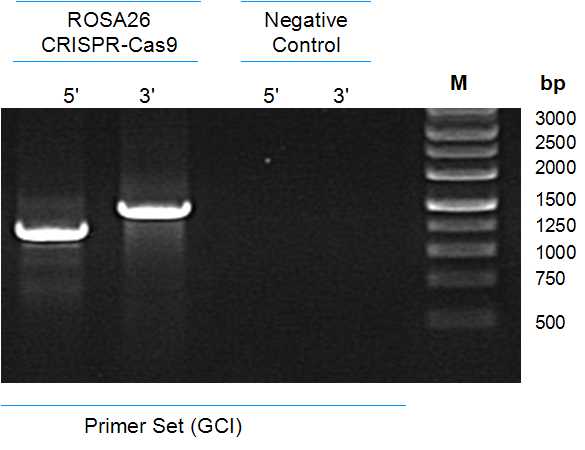 |
Figure 5. Mouse genome safe harbor ROSA26 gene targeting
(A) ROSA26 RFP control plasmid DC-RFP-SH02 (800 ng) was co-transfected with ROSA26 sgRNA/Cas9 expression clone (600 ng) or control of only control plasmid DC-RFP-SH02 (800 ng) transfected into mouse Neuro2a cells in a 6-well plate.
(B) 48 hr post-transfection, the cells were split 1:10 into a new 6-well plate and selected against 1.0 µg/ml of puromycin. The images were taken after two weeks of selection. Few colonies left in the wells transfected with only ROSA26 RFP control.
(C) PCR primers designed to amplify the HR junctions were used to verify the specific and successful integration. |
Services
mROSA26 donor clone custom services
GeneCopoeia also offers mROSA26 donor clone custom services to construct knock-in donor clones containing mutated genes or other genetic elements for targeted mROSA26 integration. To get a quote, please click here.
Questions? Please contact us at inquiry@genecopoeia.com or 1-301-762-0888.
| Services |
Description |
Application |
| Stable cell line services |
Monoclonal colony |
Monoclonal stable cell line with TALEN- or CRISPR-Cas9-mediated safe harbor transgene. |
mouse ROSA26 |
| Cell bank |
Create cell bank of monoclonal stable cell line with TALEN- or CRISPR-Cas9-mediated safe harbor transgene. |
mouse ROSA26 |
Transgenic mouse services |
Transgenic mouse |
Transgenic mice with TALEN- or CRISPR-Cas9-mediated ROSA26 transgene. |
mouse ROSA26 |
Related Products
Human AAVS1 safe harbor knockin kits and clones
Genome-TALER™ or GeneHero™ human AAVS1 safe harbor gene knock-in kit – TALEN or CRISPR-Cas9-mediated gene knock-in kits designed to specifically transfer your gene of interest, selection marker or other genetic element into the AAVS1 safe harbor site in human chromosome 19. More than 20,000 AAVS1 compatible ORF donor clones are also available. The safe integration ensures transcription-competency of the transgenes and presents no known adverse effect.
TALE and CRISPR-Cas9 products and services
Genome-TALER™ TALEN and TALE-TF custom services – GeneCopoeia offers several levels of affordable custom services for designing, creating and validating TALENs, TALE-TFs and other TAL effectors-based targeted genomic modification tools.
GeneHero™ CRISPR-Cas9 products and services – GeneCopoeia offers CRISPR-Cas9 sgRNA design and cloning services, Cas9 expression clones and other related products and services for simple and fast targeted genomic editing.
Cas9 stable cell lines
GeneHero™ CRISPR-Cas9 stable cell lines – GeneCopoeia offers stable cell lines constitutively expressing the CRISPR Cas9 nuclease for a convenient means to carry out CRISPR genome editing applications with high efficiency, especially for the highthoroughput sgRNA library screening.
Resources
Product Datasheets
Download Product Datasheets (Sales Order # is required).
Application Notes
GeneCopoeia genome editing tools for safe harbor integration in mice and humans
FAQs
FAQs about Safe Harbor gene targeting kits and clones and other genome editing products
Webinars
Watch recorded webinar: Solutions for genome editing: TALEN & CRISPR-Cas9, and Safe Harbor Knock-in ORF clones
Download webinar PPT slides
User Manual
Download User Manual








